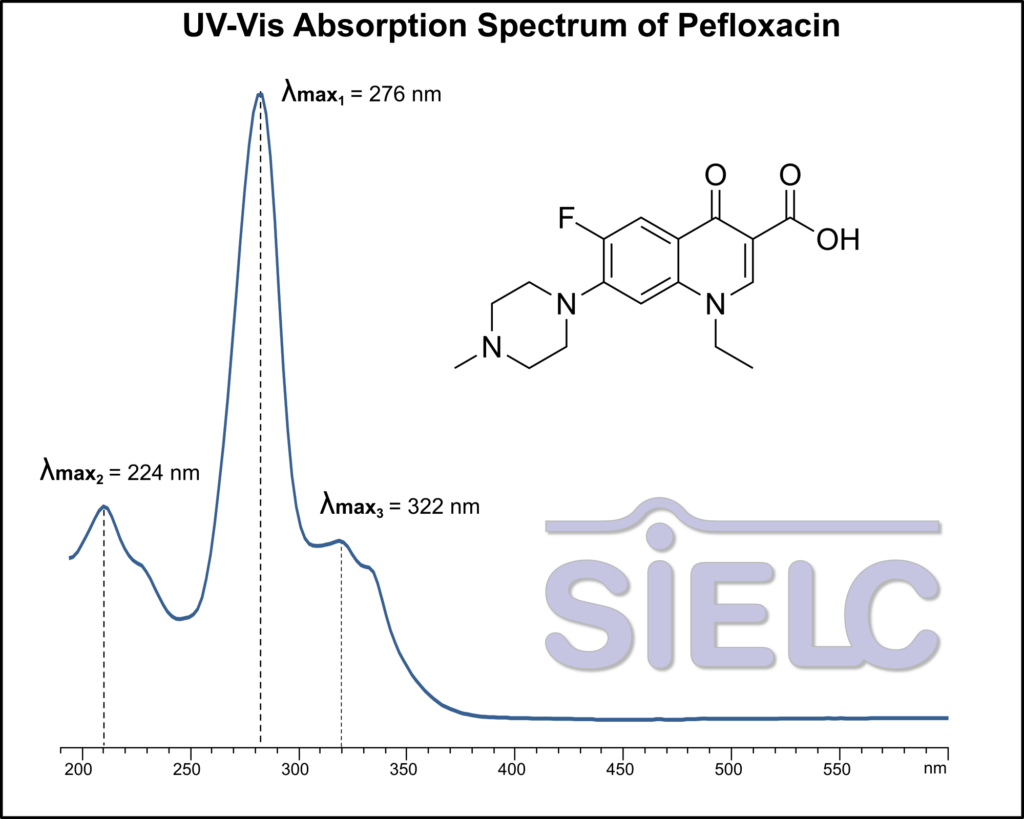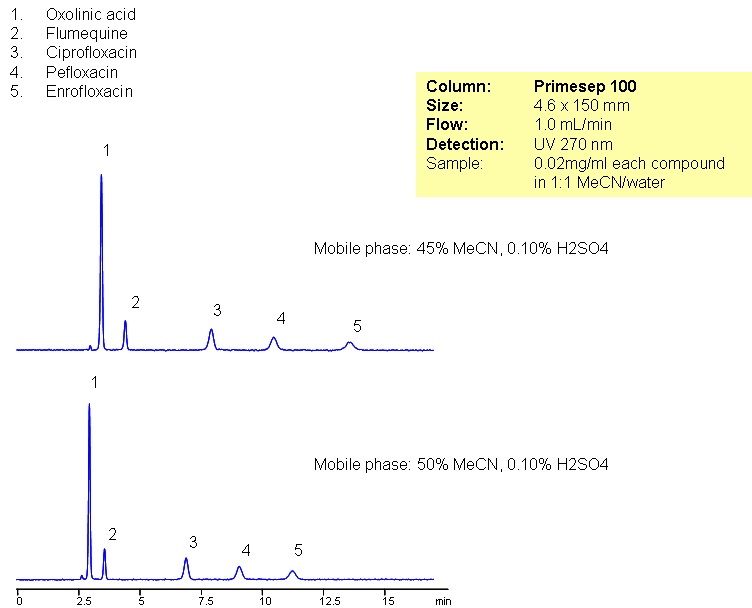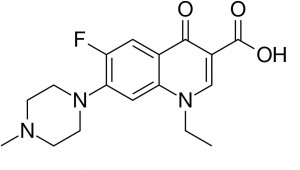| CAS Number | 70458-92-3 |
|---|---|
| Molecular Formula | C17H20FN3O3 |
| Molecular Weight | 333.363 |
| InChI Key | FHFYDNQZQSQIAI-UHFFFAOYSA-N |
| LogP | 0.27 |
| Synonyms |
|
Applications:
HPLC Method for Analysis of Pefloxacin on Primesep 100 Column
August 9, 2024
High Performance Liquid Chromatography (HPLC) Method for Analysis of Pefloxacin on Primesep 100 by SIELC Technologies
Separation type: Liquid Chromatography Mixed-mode SIELC Technologies
High Performance Liquid Chromatography (HPLC) Method for Analysis of Pefloxacin
Pefloxacin is an antibiotic that belongs to the fluoroquinolone class of drugs. It is primarily used to treat bacterial infections by inhibiting the DNA gyrase enzyme, which is essential for bacterial DNA replication and repair. Because of its mechanism, Pefloxacin is effective against a variety of gram-negative and some gram-positive bacteria.
Pefloxacin can be retained, separated and analyzed using a Primesep 100 mixed-mode stationary phase column. The analysis employs a gradient method with a simple mobile phase comprising water, acetonitrile (MeCN), and sulfuric acid as a buffer. This method allows for detection using UV 200 nm.
You can find detailed UV spectra of Pefloxacin and information about its various lambda maxima by visiting the following link.
| Column | Primesep 100, 4.6 x 150 mm, 5 µm, 100 A, dual ended |
| Mobile Phase | MeCN – 50% |
| Buffer | H2SO4 – 0.1% |
| Flow Rate | 1.0 ml/min |
| Detection | UV 200 nm |
| Limit of Detection | 40 ppb |
| Class of Compounds | quinolinemonocarboxylic acid |
| Analyzing Compounds | Pefloxacin |
Application Column
Primesep 100
Column Diameter: 4.6 mm
Column Length: 150 mm
Particle Size: 5 µm
Pore Size: 100 A
Column options: dual ended

UV-Vis Spectrum of Pefloxacin
June 28, 2024
Access the UV-Vis Spectrum SIELC Library

If you are looking for optimized HPLC method to analyze Pefloxacin check our HPLC Applications library
For optimal results in HPLC analysis, it is recommended to measure absorbance at a wavelength that matches the absorption maximum of the compound(s) being analyzed. The UV spectrum shown can assist in selecting an appropriate wavelength for your analysis. Please note that certain mobile phases and buffers may block wavelengths below 230 nm, rendering absorbance measurement at these wavelengths ineffective. If detection below 230 nm is required, it is recommended to use acetonitrile and water as low UV-transparent mobile phases, with phosphoric acid and its salts, sulfuric acid, and TFA as buffers.

HPLC Separation of a Complex of Quinolone Antibiotics
May 27, 2015

Quinolones are a group of synthetic broad-spectrum antibiotics with a wide variety of applications in medicine and veterinary sciences. Some quinolones have been found in food products including fish and shrimp. Primesep 100 was used to separate a mixture of quinolones and achieve baseline separation. Retention was controlled by adjusting acetonitrile in the mobile phase.
| Column | Primesep 100, 4.6×150 mm, 5 µm, 100A |
| Mobile Phase | MeCN |
| Buffer | H2SO4 |
| Flow Rate | 1.0 ml/min |
| Detection | UV, 270 nm |
| Class of Compounds |
Drug, Acid, Quinolone Antibiotics, Hydrophilic, Ionizable, Vitamin, Supplements |
| Analyzing Compounds | Oxolinic Acid, Flumequine, Ciprofloxacin, Enrofloxacin, Pefloxacin |
Application Column
Primesep 100
The Primesep family of mixed-mode columns offers a wide variety of stationary phases, boasting unprecedented selectivity in the separation of a broad array of chemical compounds across multiple applications. Corresponding Primesep guard columns, available with all stationary phases, do not require holders. SIELC provides a method development service available to all customers. Inquire about our specially-tailored custom LC-phases for specific separations.
Select optionsEnrofloxacin
Flumequine
Oxolinic acid
Pefloxacin



